实验3:OpenFlow协议分析实践
| 这个作业属于哪个课程 | https://edu.cnblogs.com/campus/fzzcxy/FZUZCSDN202201 |
| 这个作业要求在哪里 | https://edu.cnblogs.com/campus/fzzcxy/FZUZCSDN202201/homework/12706 |
| 这个作业的目标 | 能够运用 wireshark 对 OpenFlow 协议数据交互过程进行抓包 能够借助包解析工具,分析与解释 OpenFlow协议的数据包交互过程与机制 |
(一)基本要求
1. 搭建下图所示拓扑,完成相关 IP 配置,并实现主机与主机之间的 IP 通信。用抓包软件获取控制器与交换机之间的通信数据。
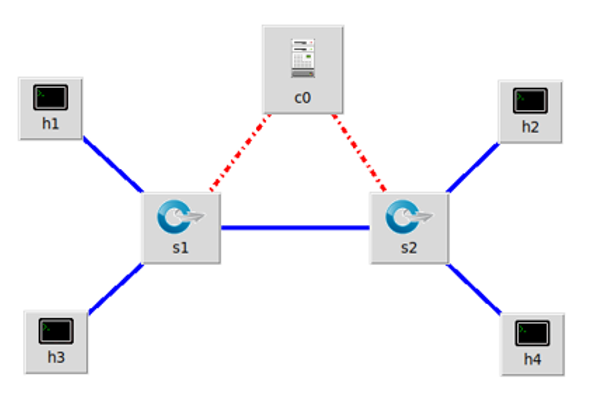
| 主机 | IP地址 |
|---|---|
| h1 | 192.168.0.101/24 |
| h2 | 192.168.0.102/24 |
| h3 | 192.168.0.103/24 |
| h4 | 192.168.0.104/24 |
2. 查看抓包结果,分析OpenFlow协议中交换机与控制器的消息交互过程,画出相关交互图或流程图。
hello
控制器6633端口(我最高能支持OpenFlow 1.0) ----> 交换机46568端口
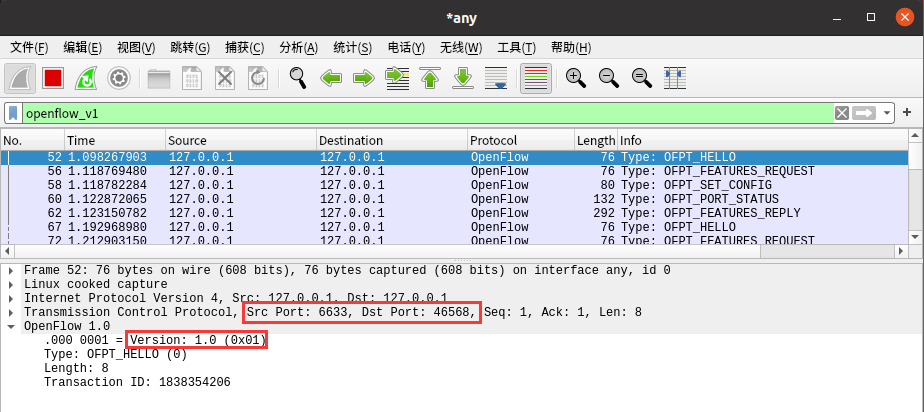
交换机46568端口(我最高能支持OpenFlow 1.5) ----> 控制器6633端口
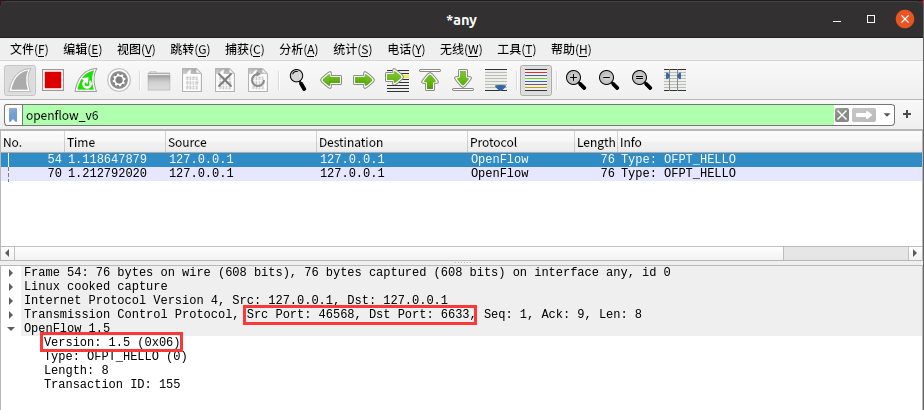
于是双方建立连接,并使用 OpenFlow 1.0
Features Request / Set Config
控制器6633端口(我需要你的特征信息)----> 交换机46568端口
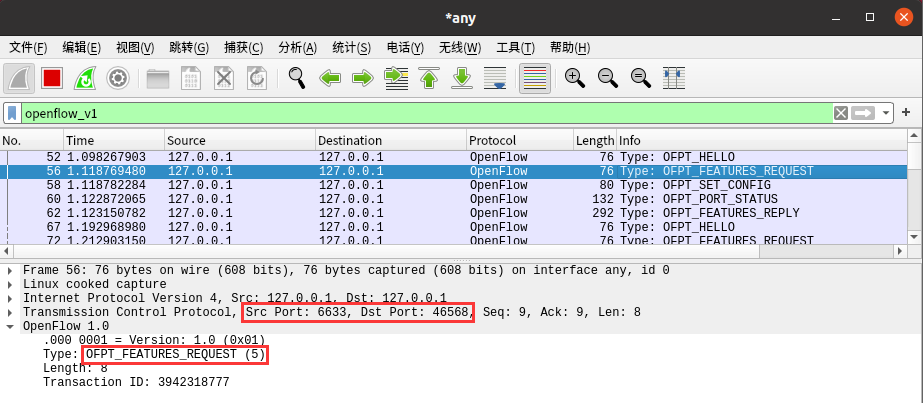
控制器6633端口(请按照我给你的flag和max bytes of packet进行配置)----> 交换机46568端口
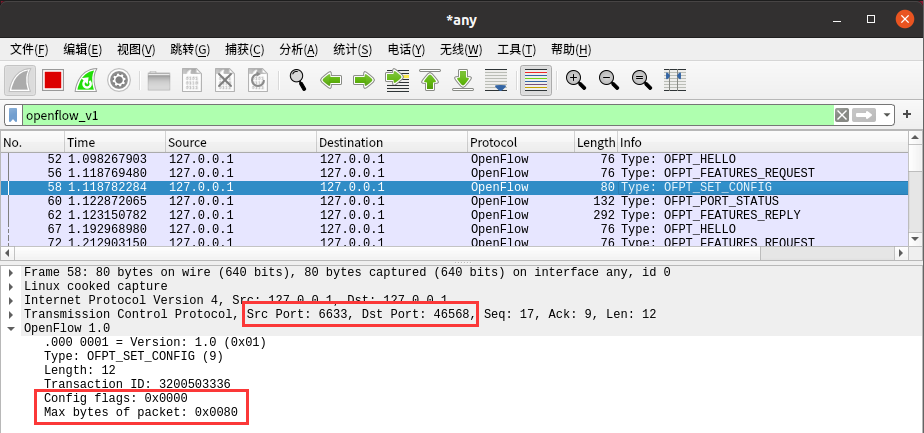
Port_Status
当交换机端口发生变化时,告知控制器相应的端口状态。
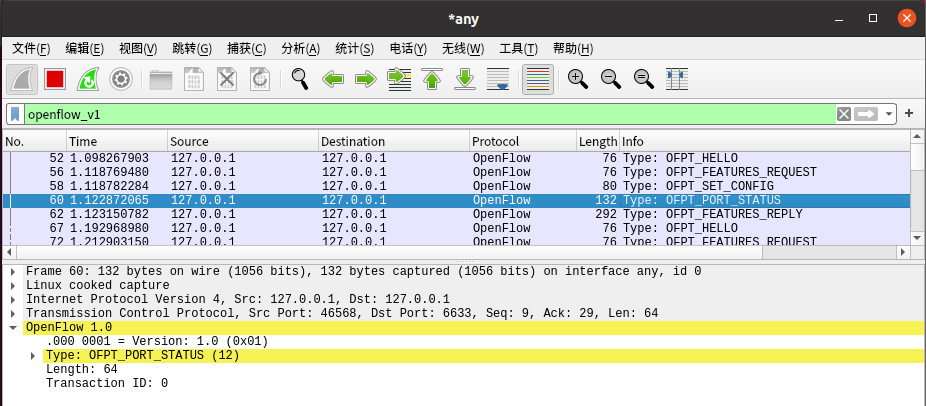
Features Reply
交换机46568端口(这是我的特征信息,请查收)----> 控制器6633端口
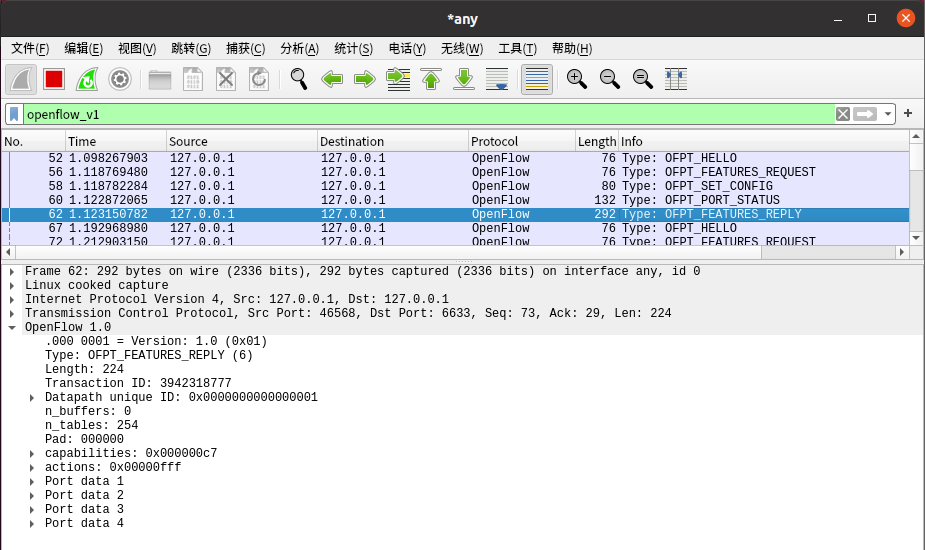
Packet_in
交换机46568端口(有数据进来,请指示) ----> 控制器6633端口

Flow_mod(控制器收到 Packet-in 消息时的响应方式之一)
控制器收到 Packet‐in 消息后,可以发送 Flow‐Mod 消息向交换机下发一个流表项
分析抓取的flow_mod的数据包,控制器通过端口6633端口向交换机46568端口、交换机46570端口下发流表项,指导数据的转发处理
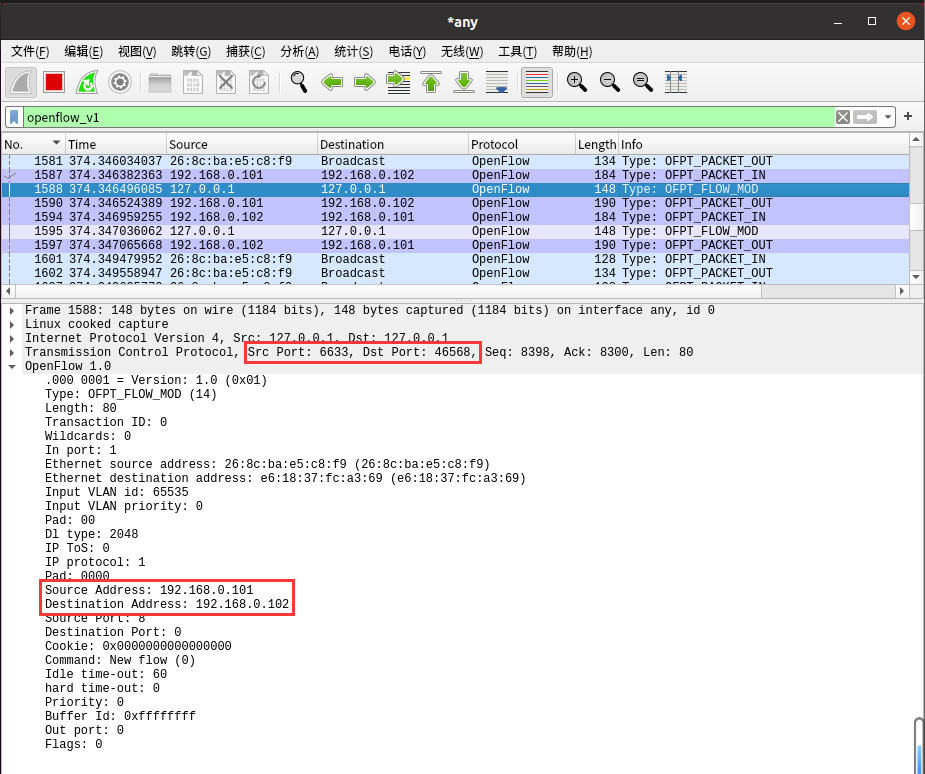
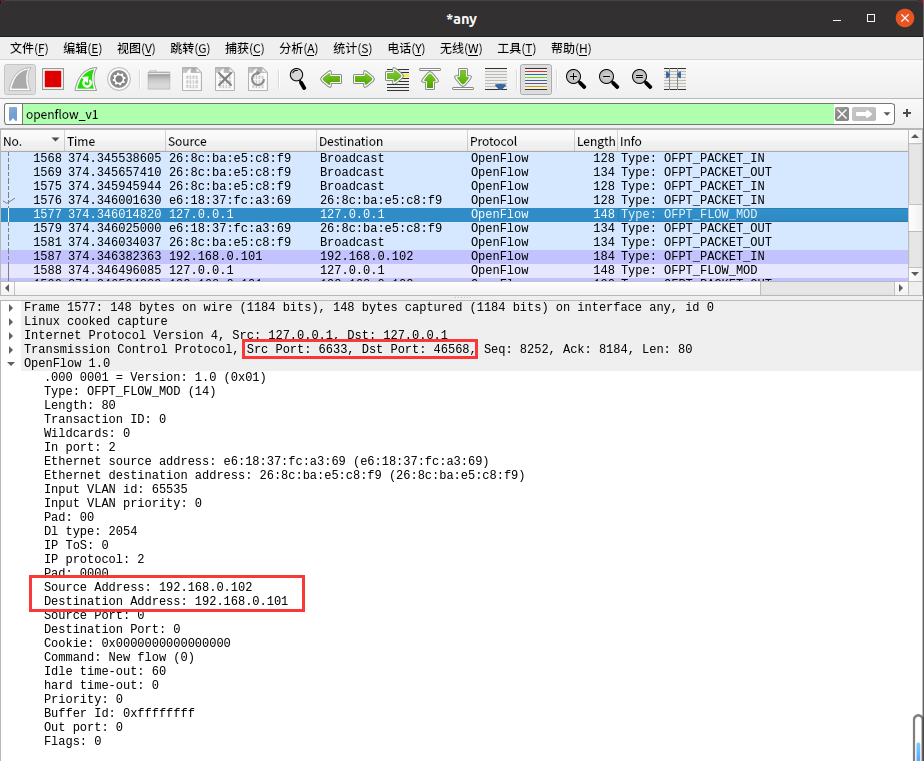
Packet_out(控制器收到 Packet-in 消息时的响应方式之一)
控制器收到 Packet‐in 消息后,控制器不会下发流表,而是直接告诉交换机该如何做
控制器6633端口(请按照我给你的action进行处理)----> 交换机46570端口
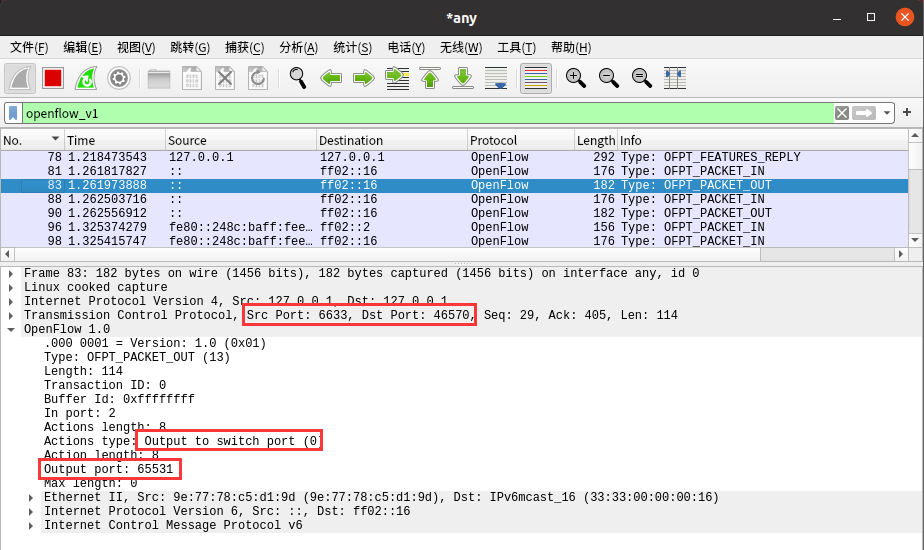
交换机与控制器的消息交互过程
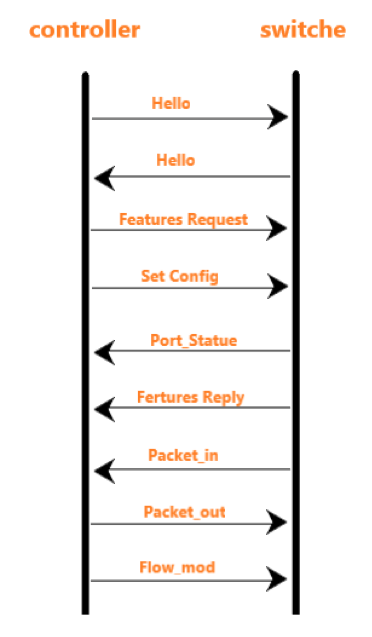
3. 回答问题:交换机与控制器建立通信时是使用TCP协议还是UDP协议?
交换机与控制器建立通信时是使用TCP协议。
(二)进阶要求
将抓包基础要求第2步的抓包结果对照OpenFlow源码,了解OpenFlow主要消息类型对应的数据结构定义。
-
hello
struct ofp_header {
uint8_t version; /* OFP_VERSION. */
uint8_t type; /* One of the OFPT_ constants. */
uint16_t length; /* Length including this ofp_header. */
uint32_t xid; /* Transaction id associated with this packet.
Replies use the same id as was in the request
to facilitate pairing. */
};
/* OFPT_HELLO. This message has an empty body, but implementations must
* ignore any data included in the body, to allow for future extensions. */
struct ofp_hello {
struct ofp_header header;
};

-
Features Request
struct ofp_header {
uint8_t version; /* OFP_VERSION. */
uint8_t type; /* One of the OFPT_ constants. */
uint16_t length; /* Length including this ofp_header. */
uint32_t xid; /* Transaction id associated with this packet.
Replies use the same id as was in the request
to facilitate pairing. */
};
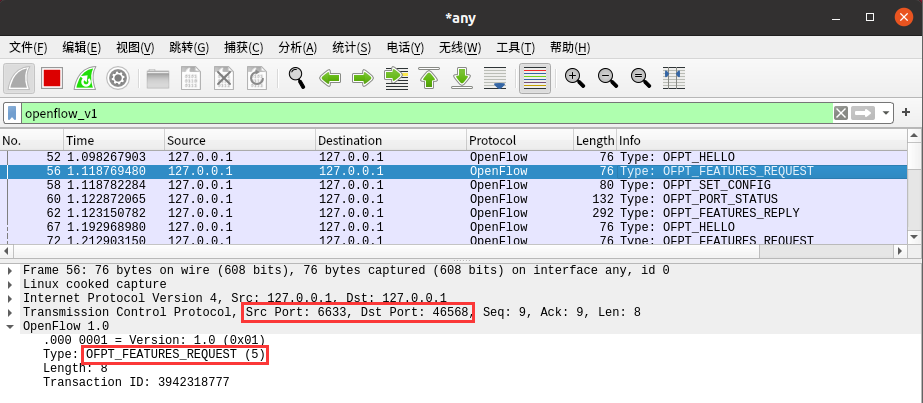
-
Set Config
struct ofp_switch_config {
struct ofp_header header;
uint16_t flags; /* OFPC_* flags. */
uint16_t miss_send_len; /* Max bytes of new flow that datapath should
send to the controller. */
};
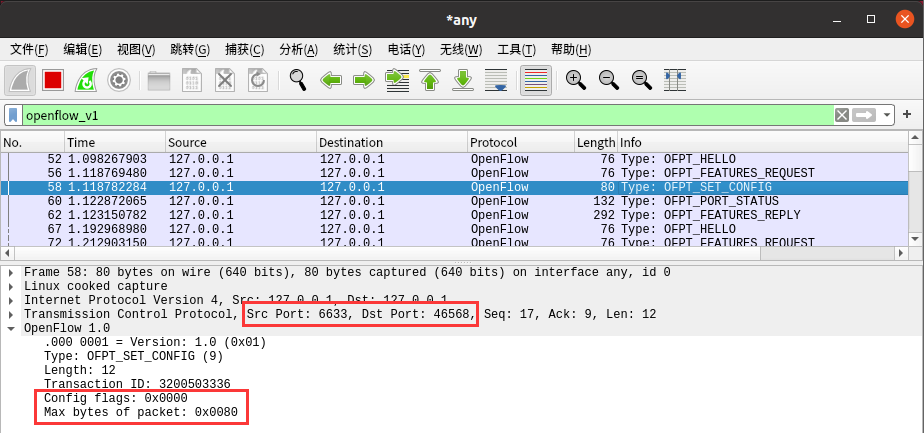
-
Port_Status
struct ofp_header {
uint8_t version; /* OFP_VERSION. */
uint8_t type; /* One of the OFPT_ constants. */
uint16_t length; /* Length including this ofp_header. */
uint32_t xid; /* Transaction id associated with this packet.
Replies use the same id as was in the request
to facilitate pairing. */
};

-
Features Reply
struct ofp_switch_features {
struct ofp_header header;
uint64_t datapath_id; /* Datapath unique ID. The lower 48-bits are for
a MAC address, while the upper 16-bits are
implementer-defined. */
uint32_t n_buffers; /* Max packets buffered at once. */
uint8_t n_tables; /* Number of tables supported by datapath. */
uint8_t pad[3]; /* Align to 64-bits. */
/* Features. */
uint32_t capabilities; /* Bitmap of support "ofp_capabilities". */
uint32_t actions; /* Bitmap of supported "ofp_action_type"s. */
/* Port info.*/
struct ofp_phy_port ports[0]; /* Port definitions. The number of ports
is inferred from the length field in
the header. */
};
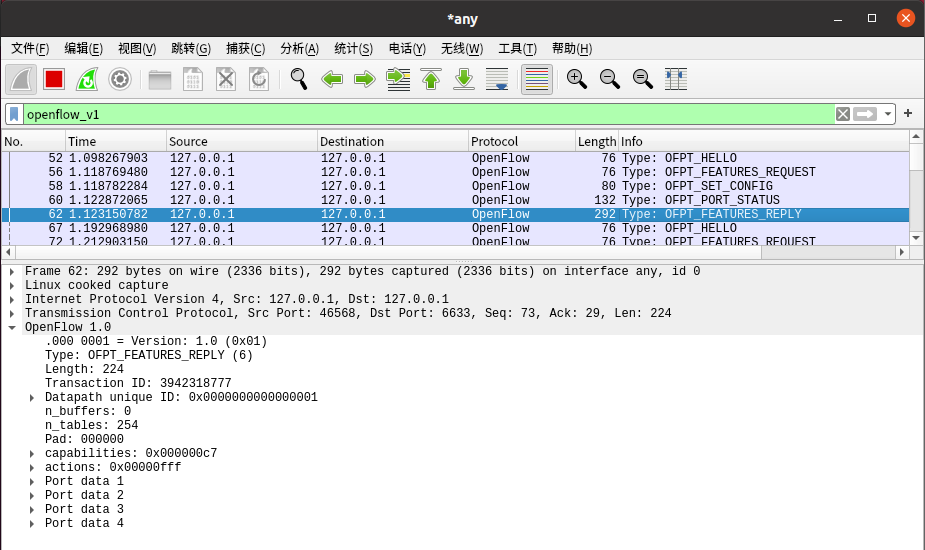
-
Packet_in
struct ofp_packet_in {
struct ofp_header header;
uint32_t buffer_id; /* ID assigned by datapath. */
uint16_t total_len; /* Full length of frame. */
uint16_t in_port; /* Port on which frame was received. */
uint8_t reason; /* Reason packet is being sent (one of OFPR_*) */
uint8_t pad;
uint8_t data[0]; /* Ethernet frame, halfway through 32-bit word,
so the IP header is 32-bit aligned. The
amount of data is inferred from the length
field in the header. Because of padding,
offsetof(struct ofp_packet_in, data) ==
sizeof(struct ofp_packet_in) - 2. */
};
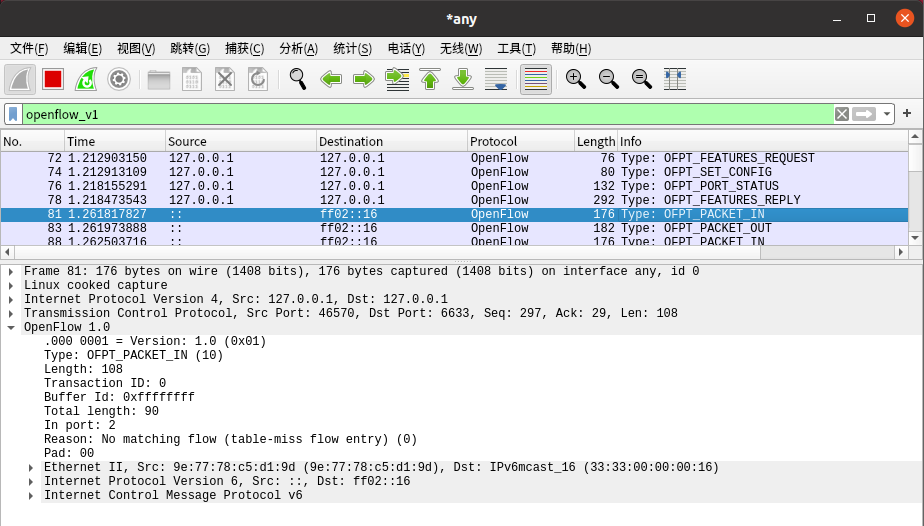
-
Flow_mod
struct ofp_flow_mod {
struct ofp_header header;
struct ofp_match match; /* Fields to match */
uint64_t cookie; /* Opaque controller-issued identifier. */
/* Flow actions. */
uint16_t command; /* One of OFPFC_*. */
uint16_t idle_timeout; /* Idle time before discarding (seconds). */
uint16_t hard_timeout; /* Max time before discarding (seconds). */
uint16_t priority; /* Priority level of flow entry. */
uint32_t buffer_id; /* Buffered packet to apply to (or -1).
Not meaningful for OFPFC_DELETE*. */
uint16_t out_port; /* For OFPFC_DELETE* commands, require
matching entries to include this as an
output port. A value of OFPP_NONE
indicates no restriction. */
uint16_t flags; /* One of OFPFF_*. */
struct ofp_action_header actions[0]; /* The action length is inferred
from the length field in the
header. */
};
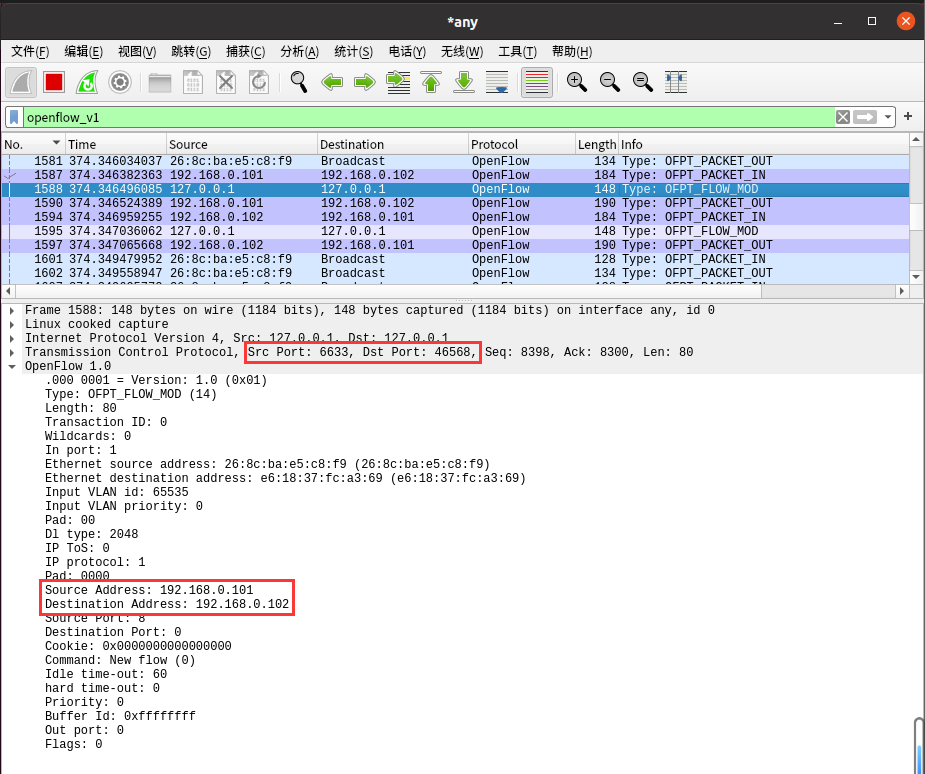
-
Packet_out
struct ofp_packet_out {
struct ofp_header header;
uint32_t buffer_id; /* ID assigned by datapath (-1 if none). */
uint16_t in_port; /* Packet's input port (OFPP_NONE if none). */
uint16_t actions_len; /* Size of action array in bytes. */
struct ofp_action_header actions[0]; /* Actions. */
/* uint8_t data[0]; */ /* Packet data. The length is inferred
from the length field in the header.
(Only meaningful if buffer_id == -1.) */
};

个人总结
- 一开始没仔细看pdf,抓包和构建拓扑的顺序反了,导致搞了好一会都找不到HELLO。
- Flow_mod的数据包在pingall之后才会出现被wireshark工具捕捉到。
- 对于如何运用 wireshark 对 OpenFlow 协议数据交互过程进行抓包有了进一步的理解。对OpenFlow协议的数据包交互过程与机制也有了更明确的认知。



